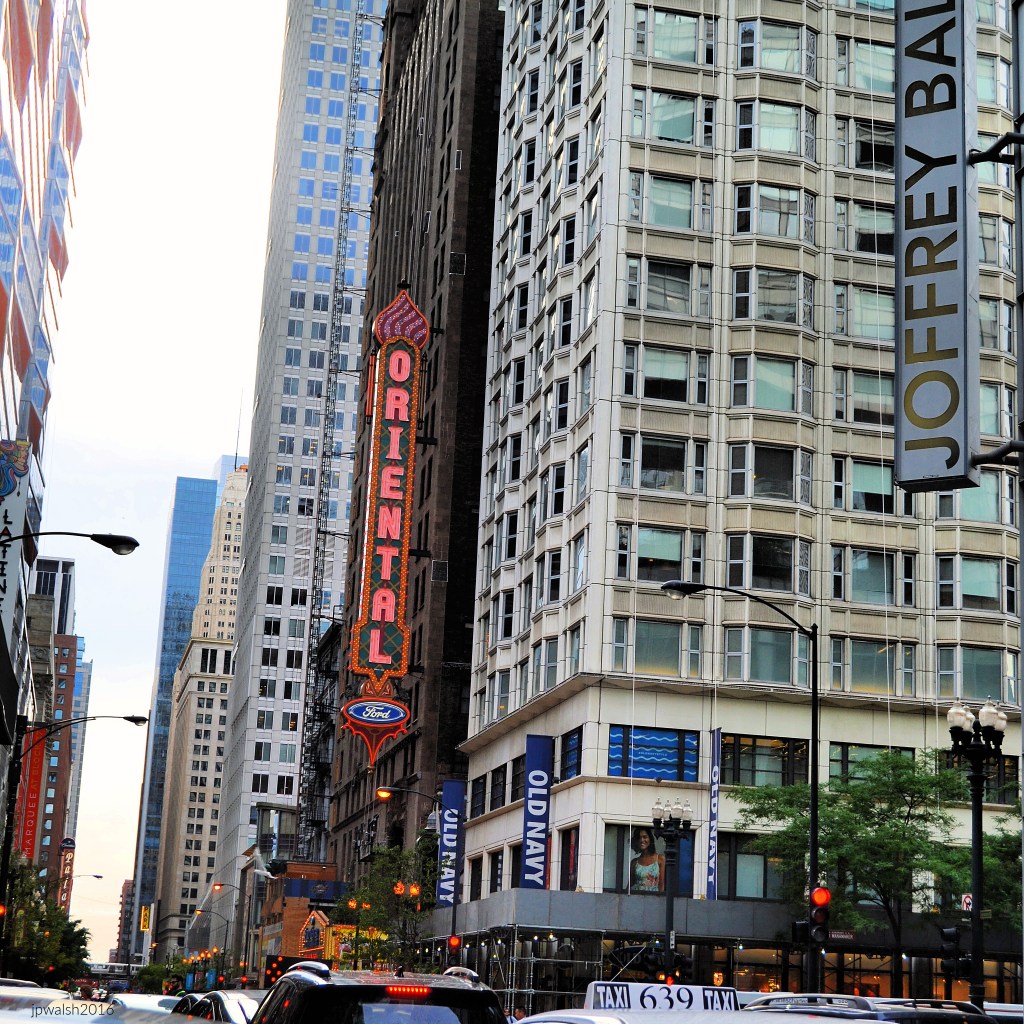
FEATURE image: Oriental Theatre completed in 1926 and renamed the Ford Center for the Performing Arts in 1997. It became the Nederlander Theatre in 2019. Author’s photograph taken in December 2017.

In Chicago’s Loop, the Oriental Theatre opened on May 8, 1926. In the first half of the 20th century, Randolph Street was one of the city’s most bustling entertainment districts.
Designed by the architectural firm of Rapp & Rapp—brothers Cornelius Ward (C.W.) Rapp (1861-1926) and George L(eslie) Rapp (1878-1941)—the Oriental Theatre was one of their many ornate movie palaces that they built. As its name implied, it was imagined in a style inspired by a Western fantasia of India and South Asian themes and motifs. Inspired by the architecture of India and the Far East, lights consisted of elephant heads with tusks, the walls were adorned with soft silk and regal velvets, and the ceiling was garishly decorated with plasterwork elephants and other exotic beasts.

Rapp & Rapp were alumni of the University of Illinois School of Architecture. The firm designed scores of theatres across the country in the first decades of the 20th century. The Rapp brothers were born in Carbondale in southern Illinois. Twenty-eight-year-old C.W. Rapp formed a partnership in 1889 with older architect, Canadian-born Cyrus P. Thomas (1933-1911) and they practiced together in Chicago until 1895. C.W. Rapp operated his own office for a decade until he formed a partnership with his brother G.L. Rapp in 1906. With stage entertainment and the boom of moving pictures after 1910, the firm of Rapp & Rapp quickly developed a reputation for their fantastic designs for silent film theatres in the Chicago area. Drawing on a large palette of architectural revival styles, Rapp & Rapp designed nearly four hundred theatres in the United States between 1906 and 1926.
In Chicago Rapp & Rapp designed notably State Street’s Chicago Theatre (1921) and the Bismarck Hotel and Theatre (1926). In New York City they built the since demolished Paramount Theatre (1926) in Times Square and the still-standing smaller-scaled Paramount Theatre (1931) in Aurora, Illinois.
In the mid1990s, after the Oriental Theatre had been closed and shuttered for over a decade, it underwent a multi-million-dollar restoration and expansion by Daniel P. Coffey & Associates. It reopened as the Ford Center for the Performing Arts in 1998. Following its expansion, the former Oriental Theatre seats over 2,000 patrons.
Entertainment legacy.
In the 1920s, the Oriental Theatre presented both movies and vaudeville acts. When talkies arrived, the Oriental Theatre became predominantly a movie house in the 1930s. Live stage, theatrical, and concert performances continued for mid20th century Chicago audiences during an era when Randolph Street was a mecca for crowds seeking out their favorite star performers. It also hosted smaller and vibrant live entertainment venues where one could seek out up-and-coming talents.
Duke Ellington and his orchestra made frequent appearances at the Oriental Theatre which welcomed patrons by way of an exotic ornate style. Some big names and legends in entertainment were seen at the Oriental Theatre including Judy Garland, George Jessel, Fanny Brice, George Burns and Gracie Allen, Cab Calloway, Eddie Cantor, Bing Crosby, Ella Fitzgerald, Jean Harlow, Billie Holiday, Bob Hope, Al Jolson, Danny Kaye, Jerry Lewis, The Marx Brothers, The Three Stooges, Frank Sinatra, Sophie Tucker, Sarah Vaughan, Henny Youngman, and a cast of thousands.
The Oriental Theatre closed in 1981 and remained shuttered for the rest of the 1980’s and into the early 1990’s depriving many young urban professionals from enjoying entertainment in a venue that, with its reopening in 1998, has operated continuously for nearly 100 years.
Ford Center for the Performing Arts in 1997 and the Nederlander Theatre in 2019.
In 1997 the Oriental Theatre was renamed the Ford Center for the Performing Arts and restored and expanded for its re-opening in 1998. In 2019 the theatre was renamed in honor of James M. Nederlander (1922-2016), Broadway theatre owner/producer and Broadway In Chicago founder.
Today’s James M. Nederlander Theatre hosts touring pre-Broadway and Broadway shows whose résumé included a long-running production of Billy Elliot: The Musical. From June 2005 through January 2009, the theater housed a full production of Wicked, making it the most popular stage production in Chicago history. In December 2017, when the feature photograph was taken, a traveling national tour of Wicked had started its Chicago run.

SOURCES:
Alice Sinkevitch, AIA Guide to Chicago, 2nd Edition, Harcourt, Inc., Orlando, 2004, p. 54.
http://www.dictionaryofarchitectsincanada.org/node/1354 – retrieved November 1, 2023.
http://www.dictionaryofarchitectsincanada.org/node/541 – retrieved November 1, 2023.
https://www.sah.org/community/sah-blog/sah-blog/2013/07/17/the-revitalized-and-the-neglected-rapp-and-rapp’s-movie-palaces-in-chicago– retrieved November 1, 2023.

Photograph & Text:



